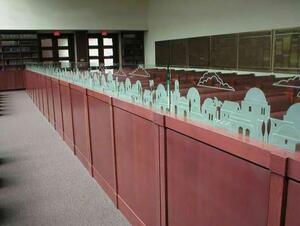“I struggle.”
“I struggle.”
This is my boss’s favorite phrase to express disagreement. While not Jewish herself, she’s an outspoken fan of Jewish culture, so it’s no surprise to me that this catch-phrase of hers is one loaded with Jewish meaning.
And that’s how I feel about mechitzas; I struggle.
Growing up, my discomfort derived from the separate-but-equal mentality I found inherent within a mechitza service. Sometimes, the mechitza is a balcony (women in the back, men in the front). Sometimes, the Torah and the service-leader are only on the men’s side. Even in the more forward-thinking mechitza services that I’ve attended, there are still areas in which women may not lead. As an outspoken queer feminist, mechitzas make me uncomfortable... to say the least.
More recently, I’ve been considering mechitzas in relation to the trans* community. While I’ve been an active member of the queer community since high school, I’ve only recently started to delve into and engage with trans* issues. At my work (which is LGBT-focused), I sit on the Trans Training Group—an initiative started to create a work environment that is not only devoid of transphobia, but respectful and affirming of all gender identities.
With this in mind, I struggle with a setting that demands a person identify as male or female—and have this identity approved by all present— in order to participate. I think of my (transmasculine) friend who went on a Birthright trip and could not engage in the holy tradition of praying at the Western Wall. He knew he would not be read as male, and thus couldn’t go on the men’s side. But he’s not a woman, and so could not pray with the women (not even considering the fact that he would have had to wear a skirt in order to participate).
For several years I worked at Congregation Beth Simchat Torah in New York, the largest LGBT Synagogue in the country. As part of their outreach, CBST had produced an informational brochure about becoming a trans-inclusive congregation. The brochure addressed the statement “But my congregation doesn’t have any trans individuals!” with “What have you done to make your congregation inclusive and welcoming to trans individuals?” I struggle to reconcile a mechitza service with a service that is trans*-inclusive, welcoming, and affirming. I honestly don’t know if it’s possible.
As a ciswoman, yes, I have felt discomfort in participating in mechitza services. But it’s different for trans* individuals. I have been able to find my side of the divider. I have been able to know that my choice will not be questioned. I know that my religion recognizes me as a component of the prayer service. I do not have to worry about others debating my gender identity (either out loud or to themselves). I do not have to worry about someone telling me that I am sitting on the wrong side.
A few more takes on Gender & Judaism:
With all this said, I do have friends that actively participate in services with mechitzas. And some of them are rather progressive in general. I acknowledge that often the mechitza is not what draws them to a service. It is a part, but not the main draw. I know that to leave a mechitza service may mean to leave one’s shul, and that community, and I know it is difficult to make change. To challenge tradition. To push back.
But… I struggle.
And I hope they do too.






